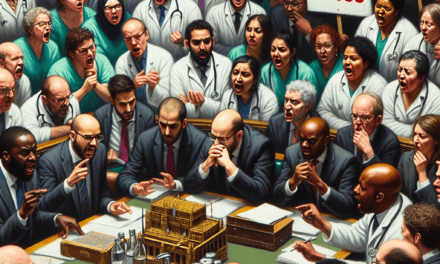Supreme Court Delivers Setback to Hospitals in DSH Formula Ruling
The recent ruling by the Supreme Court regarding the Disproportionate Share Hospital (DSH) formula has sent shockwaves through the healthcare community, particularly among hospitals that serve a high number of low-income patients. This decision has significant implications for the funding and operational capabilities of these institutions, which are often the backbone of healthcare in underserved communities. In this article, we will explore the details of the Supreme Court’s ruling, its implications for hospitals, the DSH formula itself, and the broader context of healthcare funding in the United States.
Understanding the Disproportionate Share Hospital (DSH) Program
The Disproportionate Share Hospital program was established under the Social Security Act to provide financial assistance to hospitals that serve a large number of low-income patients. The rationale behind the DSH program is straightforward: hospitals that treat a higher percentage of uninsured and underinsured patients face unique financial challenges. The DSH payments are intended to help these hospitals maintain their operations and continue providing essential services to vulnerable populations.
DSH payments are calculated based on a formula that considers several factors, including the number of Medicaid patients served and the hospital’s overall financial health. The formula is designed to ensure that hospitals with a higher burden of uncompensated care receive more substantial support. However, the complexities of the formula and the evolving landscape of healthcare funding have led to ongoing debates about its effectiveness and fairness.
The Importance of DSH Payments
DSH payments play a critical role in the financial stability of many hospitals, particularly those in urban and rural areas that serve low-income populations. These payments help cover the costs associated with treating patients who cannot pay for their care, thereby allowing hospitals to continue operating without compromising the quality of care. The importance of DSH payments can be highlighted through several key points:
- Financial Viability: Many hospitals rely on DSH payments to offset losses incurred from treating uninsured patients. Without these funds, some hospitals may face closure, leading to reduced access to care for vulnerable populations.
- Quality of Care: DSH payments enable hospitals to invest in necessary resources, such as staff, equipment, and technology, which ultimately improve patient outcomes.
- Community Health: Hospitals that receive DSH payments often provide essential services, including emergency care, maternal health, and chronic disease management, which are vital for community health.
Despite the importance of DSH payments, the program has faced scrutiny and calls for reform. Critics argue that the formula is outdated and does not accurately reflect the current healthcare landscape, particularly as the number of uninsured patients has fluctuated in recent years due to policy changes and economic factors.
The Supreme Court Ruling: Key Details and Implications
The Supreme Court’s recent ruling on the DSH formula has significant implications for hospitals across the country. The case, which centered on how DSH payments are calculated, has raised questions about the future of funding for hospitals that serve low-income populations. The ruling has been characterized as a setback for hospitals, as it upheld a more restrictive interpretation of the DSH formula that could lead to reduced funding for many institutions.
In the case, the Supreme Court examined the methodology used by the Centers for Medicare & Medicaid Services (CMS) to calculate DSH payments. The Court’s decision favored CMS’s approach, which has been criticized for potentially underestimating the financial burden faced by hospitals serving low-income patients. The ruling has sparked concerns among healthcare advocates and hospital administrators about the long-term viability of DSH funding.
Immediate Effects on Hospitals
The immediate effects of the Supreme Court ruling are likely to be felt across the healthcare system. Hospitals that rely heavily on DSH payments may face budget shortfalls, leading to difficult decisions about staffing, services, and patient care. Some of the immediate consequences include:
- Budget Cuts: Hospitals may need to implement budget cuts, which could result in layoffs, reduced services, or even closures, particularly in rural areas where healthcare options are already limited.
- Increased Financial Strain: The ruling may exacerbate existing financial challenges for hospitals, particularly those that have already been struggling due to the COVID-19 pandemic and rising operational costs.
- Impact on Patient Care: Reduced funding could lead to longer wait times, decreased access to specialized services, and overall lower quality of care for patients who rely on these hospitals.
As hospitals grapple with the implications of the ruling, many are calling for legislative action to address the shortcomings of the DSH formula and ensure that hospitals serving low-income populations receive adequate support.
The Broader Context of Healthcare Funding in the U.S.
The Supreme Court’s ruling on the DSH formula is just one piece of a larger puzzle regarding healthcare funding in the United States. The healthcare system is complex and multifaceted, with various funding sources and mechanisms that impact how care is delivered. Understanding this broader context is essential for grasping the significance of the ruling.
Healthcare funding in the U.S. comes from a mix of public and private sources, including Medicare, Medicaid, private insurance, and out-of-pocket payments. Each of these funding streams has its own set of rules and regulations, which can create challenges for hospitals and healthcare providers. Some key points to consider include:
- Medicaid Expansion: The expansion of Medicaid under the Affordable Care Act (ACA) has had a significant impact on hospital funding. States that expanded Medicaid have seen reductions in uninsured rates, which has led to decreased reliance on DSH payments. However, states that did not expand Medicaid continue to face challenges in funding hospitals that serve low-income populations.
- Rising Costs: The rising costs of healthcare, including labor, technology, and pharmaceuticals, have put additional pressure on hospitals. Many institutions are struggling to balance their budgets while providing high-quality care.
- Policy Changes: Changes in federal and state healthcare policies can have immediate and far-reaching effects on hospital funding. For example, changes to reimbursement rates or eligibility criteria for Medicaid can directly impact the financial health of hospitals.
In this complex landscape, the Supreme Court’s ruling on the DSH formula highlights the need for ongoing advocacy and reform to ensure that hospitals can continue to serve their communities effectively.
Case Studies: Hospitals Affected by DSH Funding Changes
To better understand the real-world implications of the Supreme Court’s ruling on DSH funding, it is helpful to examine specific case studies of hospitals that have been affected by changes in DSH payments. These examples illustrate the challenges faced by hospitals serving low-income populations and the potential consequences of reduced funding.
Case Study 1: Urban Safety-Net Hospital
One urban safety-net hospital located in a major metropolitan area has long relied on DSH payments to support its operations. This hospital serves a diverse patient population, including a significant number of uninsured and underinsured individuals. In recent years, the hospital has faced increasing financial strain due to rising operational costs and changes in reimbursement rates.
Following the Supreme Court’s ruling, the hospital’s leadership expressed concern about the potential for reduced DSH payments. The hospital’s CEO noted that any decrease in funding could lead to difficult decisions about staffing and services. The hospital has already implemented cost-cutting measures, including layoffs and service reductions, in response to previous funding challenges. The CEO emphasized that further cuts could jeopardize the hospital’s ability to provide essential services, such as emergency care and maternal health programs.
Case Study 2: Rural Community Hospital
A rural community hospital that serves a low-income population has also been significantly impacted by changes in DSH funding. This hospital has historically relied on DSH payments to cover the costs of treating uninsured patients. However, as the healthcare landscape has evolved, the hospital has faced increasing challenges in maintaining financial stability.
In light of the Supreme Court’s ruling, the hospital’s board of directors convened to discuss potential strategies for addressing the anticipated funding shortfall. The board recognized that the hospital plays a critical role in the community, providing essential services such as primary care, emergency services, and chronic disease management. However, the board also acknowledged that without adequate funding, the hospital’s future could be at risk.
The hospital’s leadership is exploring alternative funding sources, including grants and partnerships with local organizations, to help mitigate the impact of reduced DSH payments. However, the uncertainty surrounding future funding remains a significant concern for the hospital and its stakeholders.
Advocacy and Future Directions for DSH Funding
In the wake of the Supreme Court’s ruling, advocacy efforts are ramping up to address the challenges facing hospitals that serve low-income populations. Healthcare advocates, hospital administrators, and policymakers are calling for reforms to the DSH formula to ensure that hospitals receive adequate support to continue providing essential services.
Advocacy Efforts
Advocacy organizations are mobilizing to raise awareness about the importance of DSH funding and the potential consequences of reduced payments. Key strategies include:
- Public Awareness Campaigns: Advocacy groups are launching campaigns to educate the public about the role of DSH payments in supporting hospitals that serve low-income populations. These campaigns aim to highlight the potential impact of funding cuts on patient care and community health.
- Engaging Policymakers: Advocates are working to engage policymakers at both the state and federal levels to push for reforms to the DSH formula. This includes advocating for increased funding and more equitable distribution of resources to hospitals serving high numbers of low-income patients.
- Building Coalitions: Healthcare organizations are forming coalitions to amplify their voices and advocate for change. By coming together, these organizations can present a united front and increase their influence in policy discussions.
As advocacy efforts continue, it is essential for stakeholders to remain vigilant and proactive in addressing the challenges posed by the Supreme Court’s ruling. The future of DSH funding will depend on the collective efforts of healthcare advocates, hospital leaders, and policymakers to ensure that hospitals can continue to serve their communities effectively.
Conclusion: The Path Forward for DSH Funding
The Supreme Court’s ruling on the DSH formula represents a significant setback for hospitals that serve low-income populations. As these institutions grapple with the implications of reduced funding, it is crucial to recognize the importance of DSH payments in supporting their operations and ensuring access to care for vulnerable communities.
In light of the ruling, hospitals must navigate a complex landscape of healthcare funding while advocating for reforms to the DSH formula. The challenges faced by hospitals are not insurmountable, but they require concerted efforts from all stakeholders involved in the healthcare system. By working together, advocates, hospital leaders, and policymakers can help shape a future where hospitals can continue to provide essential services to those who need them most.
As we move forward, it is essential to keep the conversation about DSH funding alive and to prioritize the needs of hospitals serving low-income populations. The health of our communities depends on it.





